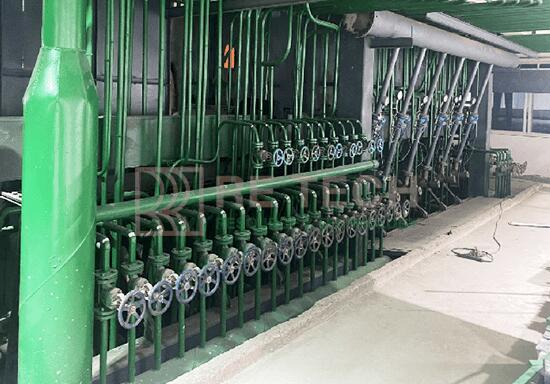Oxygen-enriched side-blowing furnace production process
Mar. 07, 2025
In fact, the oxygen-enriched side-blowing smelting process is an upgrade of the Vanyukov copper smelting process and has been adopted by more than a dozen copper smelting companies. After this copper smelting process was put into production, it not only increased the oxygen-enriched concentration, but also effectively reduced the fuel rate and improved production efficiency. While increasing the economic benefits of the enterprise, it also showed good environmental protection and energy-saving effects. Therefore, studying the oxygen-enriched side-blowing furnace copper smelting process has great production value for copper smelting production.
1. Process principle analysis
In the high-concentration oxygen-rich low-carbon copper smelting process, an oxygen-rich side-blowing furnace is used. This is an oxygen-rich smelting furnace that can dry materials, roast materials, and smelt materials in one furnace. The oxygen-rich side-blowing furnace draws air from the wind eyes on both sides and controls the air to blow directly into the slag layer. Other concentrates, cold copper matte, solvents, and fuels also need to be mixed evenly in the main belt through the metering belt in a specific proportion. Finally, the main transport belt is used to add materials to the furnace at the top of the furnace. After obtaining the copper matte, the copper matte is placed into the copper bag through the copper chute according to the converter cycle. The flue gas will be cooled by the waste heat boiler and returned to the sulfuric acid system after the electrostatic precipitator completes the dust collection process.
The low-carbon economy requires that under the concept of sustainable development, through technological innovation, copper industry transformation and energy development, the consumption of high-carbon energy is reduced, gas pollution is further controlled, and a good environmental protection effect is achieved. In copper smelting production, the development of a low-carbon economy is not only for enterprises to assume low-carbon environmental protection responsibilities and achieve energy-saving and consumption-reduction targets. It is also for copper smelting enterprises to adjust their economic structure, improve energy efficiency, focus on developing new processes, and build an economic and environmentally friendly society. The use of oxygen-enriched side-blown furnaces can effectively reduce coal blending rates, reduce carbon dioxide emissions, reduce waste gas emissions, and achieve good low-carbon environmental protection effects.
This process can not only process concentrates, but also process complex polymetallic ores, so that resources can be comprehensively utilized. The source of this process is very wide, which broadens the raw material supply channels and maximizes the utilization of mineral resources. Due to the high oxygen enrichment concentration, the smelting intensity is higher. In addition, this process is very convenient to operate. During the copper smelting production process, this copper smelting process is easier for production personnel to master, which can effectively improve production efficiency. The airflow blows in from both sides, the contact area with the metal is larger, and the gas residence time is longer, so that the metal utilization rate can be maximized.

2. Analysis of oxygen-enriched side-blowing furnace structure
The internal lining of the oxygen-enriched side-blown furnace is made of refractory materials. A rectangular furnace with a copper water jacket is set in the main part. The main structure includes the foundation, furnace bottom, tuyere, furnace top, steel structure, copper water jacket and slag chamber. The foundation is mainly composed of mixed soil, and the furnace bottom and furnace are built with magnesium-chromium bricks. Copper water cooling parts are used above the slag chamber, boiler steel plates are used to weld the cooling parts on the furnace top, and magnesium-chromium is used to pound the materials at the bottom. Two charging ports are set on the furnace top, and they are sealed with air seals. A slag chamber is used at the front end of the furnace to separate the slag copper.
3. Production Process
3.1 Air Operation
First, it is necessary to increase the oxygen enrichment concentration in the Oxygen Enriched Side Blown Furnace to within the range of 80% to 85%, further improve the self-heating degree of the smelting furnace, produce sulfur dioxide, make sulfuric acid production more convenient, and help reduce production costs. In this process, strict control of process indicators is very important. Under low oxygen enrichment conditions, the oxygen enrichment concentration is controlled within the range of 62% to 65%; the fuel rate is controlled within the range of 3.3% to 3.6%; the bed capacity index is 75t/ m2 ·d; the furnace temperature index is 1180℃~1200 ℃ ; the Fe/ SiO2 index is 1.25%~1.3%; and the SO2 concentration index is 25%~28%. Under high oxygen enrichment conditions, the oxygen enrichment concentration is controlled within the range of 80% to 85%; the fuel rate is controlled within the range of 2.7% to 3.0%; the bed capacity index is 80t/ m2 ·d; the furnace temperature index is 1200℃ to 1250 ℃ ; the Fe/ SiO2 index is 1.45% to 1.6%; and the SO2 concentration index is 30% to 32%.
3.2 Parameter Control
Only at the right temperature can the charge melt quickly and react. Therefore, it is necessary to control the temperature of the matte furnace, and also control key indicators such as the production slag type. In order to obtain better production results, it is necessary to control the indicators according to the furnace temperature, matte grade and slag type, and adjust the furnace temperature first.
(1) When the slag type is appropriate and the slag quality is good, if the matte grade is relatively low and the furnace temperature is low, then the oxygen flow rate needs to be controlled first and adjusted to the maximum value. If the oxygen flow rate and oxygen enrichment concentration reach the maximum value, the feed amount may be too large and material reduction is required.
(2) If the matte grade is not high and the furnace temperature is high, it is mainly caused by high-sulfur ore. While ensuring high oxygen concentration, first focus on reducing fuel, then refer to temperature changes, appropriately adjust the proportion of low-sulfur ore, and increase the proportion of high-sulfur ore.
(3) If the grade of the matte is relatively high and the temperature in the furnace is also relatively high, when this happens, the oxygen enrichment concentration can be adjusted to the highest level, the content of useful gas can be increased, all high-sulfur ores can be used, or the proportion of high-sulfur ores can be increased. After increasing the temperature in the furnace and keeping it stable, the material can be added and the grade of the matte can be reduced.
Alternatively, you can keep the proportion of ingredients unchanged, appropriately increase the proportion of high-sulfur ore, control the amount of added materials, increase the amount of ignition fuel, and when the temperature in the furnace rises, add materials to reduce the grade of matte.
(4) If the matte grade is high and the furnace temperature is high, it is mostly because the amount of charge is too small. There is no need to change the oxygen concentration in the furnace. You can increase the charge amount and control the matte grade and furnace temperature until they reach the appropriate level.
3.3 Controlling copper content
Finally, the copper content needs to be controlled, of which 0.75% is the copper content of the smelting slag. After passing through the chute, the smelting slag is placed in a copper bag for cooling treatment. After crushing, the whole slag is flotated in proportion with the converter slag to obtain slag concentrate, which is returned to the smelting furnace for continued use. In this process, the control of the copper content requires the use of high-concentration oxygen enrichment to control the furnace temperature at around 1200°C, and the copper content of the slag is effectively reduced after slow cooling treatment.
4. Notes
4.1 Control the smoke rate
During the production process, the oxygen-enriched low-carbon copper smelting process will produce a lot of smoke and dust, which is caused by the insufficient oxygen concentration. Therefore, the oxygen concentration must be strictly controlled first to ensure that the oxygen concentration is maintained at a high level, thereby reducing the amount of smoke generated. Secondly, it is necessary to add a gas seal at the discharge port, changing from negative pressure to micro-negative pressure, thereby reducing the amount of mineral powder that can be carried away by the smoke and reducing the smoke rate.
4.2 Controlling the formation of free sulfur
In a high-intensity smelting furnace, due to the high desulfurization rate, the flue gas has a high content of single sulfur bodies in the initial stage of production, which will have a serious impact on the sulfuric acid system and even have an adverse effect on the stable operation of the molten pool smelting furnace. Therefore, it is necessary to control the generation of single sulfur, and strengthen the control of the material amount, coal particle size and the way of adding coal blocks. Supplement the secondary air and control the oxygen content of the flue gas of the waste heat boiler to control the oxygen content within the range of 3% to 5%, so as to increase the oxygen enrichment concentration, increase the self-heating Chengdu of the smelting furnace, and reduce the input of low-sulfur ore. This can effectively reduce the formation of single sulfur.
4.3 Maintaining upper combustion
During production, as the flue gas from the waste heat boiler continues to rise, coking occurs in the flue. It is necessary to adjust the volatilization and intensity of the coal to complete the combustion in the upper part as much as possible, so that the flue gas temperature is increased, thereby reducing the amount of coking.
5 Conclusion
In summary, this article analyzes the process principle and the structure of the oxygen-enriched side-blowing furnace, and emphasizes that the copper smelting process should strengthen the control of air operation, production parameters, and copper content. At the same time, attention should be paid to the control of smoke rate and elemental sulfur, and the upper combustion should be maintained as much as possible.
This copper smelting process has great application advantages because it has strong adaptability to materials, very compact process configuration, and relatively low production investment. While providing strong smelting, this smelting process actively uses waste heat recovery and depletion technology, which has good environmental benefits.
Pressure swing adsorption oxygen generator is very suitable for oxygen-enriched copper smelting. PKU Pioneer VPSA oxygen generator can produce low-cost oxygen on a large scale, and has many advantages such as convenient start and stop, flexible load adjustment, and high online rate. So far, dozens of copper smelting enterprises at home and abroad have chosen to use PKU Pioneer oxygen generator, among which the highest continuous purchase record of a single user is 6 sets, which is enough to prove the full trust of the majority of copper smelting users in PKU Pioneer VPSA oxygen generator.
47
0
0
None
None

Comments
All Comments (0)